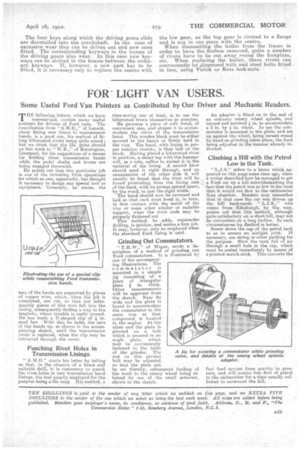FOR LIGHT VAN USERS.
Page 33

If you've noticed an error in this article please click here to report it so we can fix it.
Some Usetui Ford Van Pointers as Contributed by Our Driver and Mechanic Readers.
THE following letters, which we have summarized, contain many useful pointers for drivers of Ford vans. The contribution from "A.M.D.," of Lanark, about fitting new liners to transmission bands, is a good one, his method of fitting bifurcated rivets being quite sound ; but we think that the 15s. prize should go this week to " WE.," of Kensington, Liverpool, for his suggestions of a means for holding these transmission bands while the pedal shafts and levers are being engaged therewith.
He points out that this partkular job Is one of the irritating little operations for which no one, apparently, has thought it necessary to design any special tool or equipment. Generally, he states, the
ears of the bands are supported by pieces of copper wire, which, when the job is completed, are cut, so that not infrequently pieces of this wire fall into the easing, subsequently finding a way to the magneto, where trouble is easily caused. He has made a U-shaped clip of lr in. steel bar. With this he holds the ears of the bands up, as shown in the accompanying sketch, until the transmission cover is replaced, when the clip may be extracted through the cover.
Punching Rivet Holes in Transmission Linings.
" A.M.D." starts his letter by telling us that, in the absence of a brace and suitable dull, it is customary to punch the rivet holes in new transmission band linings, the tool usually employed for the purpose being a•file tang. His method, a
time-saving one at least, is to use the bifurcated rivets themselves as punches.
He procures a piece of soft wood, of convenient size,-and shapes it to accommodate the curve of the transmission band. This wooden block must be either secured to the bench or firmly held in the vice. The band, with lining in proper relation thereto, is then laid on the block. Having placed a bifurcated rivet in position, a smart tap with the hammer will, as a rule, suffice to embed it in the material of the lining. A second blow should send it right through, and on examination of the other side it will usually be found that the rivet will be found protruding from the lining side of the band, with its prongs spread apart, by the wood, to just the right width.
The band should now be reversed and laid so that each rivet head is, in turn, in firm contact with the Metal of the vice or some other similar or suitable support, when the rivet ends may be properly flattened out This method, he adds, supersedes drilling, is quicker, and makes a firm job. It may, however, only be employed when the standard Ford lining is used
Grinding Out Commutators. " T.EI.W.," of Wigan, sends a 'description of a method of grinding out, Ford commutators. It is illustrated by one of the accompanying illustrations. The commutator is mounted in a simple jig consisting. of a piece of triangular
plate in. thick. Other measurements will be apparent from the sketch. Near its wide end the plate is bored to accommodate the commutator in the same way as that component is located in the engine. At the other end the plate. is pivoted on a bolt which is secured in an angle plate, which may be conveniently fastened to the table of the grinder. The not on this pivotal bolt may be adjusted so that the plate can be set thereby, subsequent feeding of the work to the emery wheel being attained by use of the small setscrew, shown in the sketch.
An adapter is fitted on to the end of an ordinary emery wheel spindle, and turned and screwed & in. to accommodate a 2 in. by in. wheel. In use the commutator is mounted in the plate, and set up against the wheel, being turned round by hand as grinding takes place, the feed being adjusted in the manner already indicated.
Climbing a Hill with the Petrol Low in the Tank.
" L.J.S." refers to a-letter which appeared on this page some time ago, when a writer described how he managed to get a Ford car up a hill notwithstanding the fact-that the petrol was so low in the tank that it would not flow to the carburetter float chamber. Readers may remember that in that case the car was driven up the hill backwards. " L.J.S.," who comes from Edinburgh, by the way, points out that this method, although quite satisfactory on a short hill, may not be convenient on a long incline. In such circumstances his rtetbod is better.
Screw down the cap of the petrol tank so as to ensure an airtight joint. If necessary, use string or other packing for the purpose. Blow the tank full of air through a small hole in the imp, which mnst be sealed immediately by means of a pointed match-stick. This converts the


































